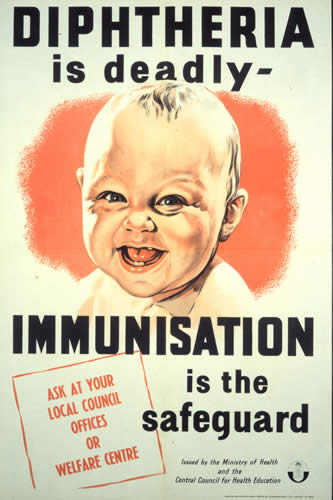Immunization is supposed to protect children from communicable diseases. However, out of ignorance or negligence, some parents have by themselves jeopardized the lives of their children.

A child being given immunization. (Image credit: Google Image)
Diphtheria is an acute, toxin-mediated disease caused by Corynebacterium diphtheria. It usually affects under 5 children although non-immune young adult may also be affected.
There is no racial nor sex predilection. It can equally affect male and female; Black or Caucasian. Transmission is most often person to person spread from the respiratory tract.
It can affect any mucosal membrane in the body. The clinical features depend on the affected site or part of the body.
RISK FACTOR
This include: incomplete immunization, overcrowding, and immunocompromised state.
SIGNS AND SYMPTOMS
These depend on the affected part of the body. The incubation period is 2-5days but ranges from 1-10days.
Respiratory involvement often begins with sore throat, difficulty in breathing and cough. Anterior nasal diphtheria is usually characterized by a mucopurulent nasal discharge (containing both mucus and pus).
The most common sites of infection are the pharynx and the tonsil (at the back of the mouth). It is often characterized with sore throat, low grade fever, bluish white membrane over the tonsils which over time turns greyish-green.
Signs include: severe prostration, pallor, tachycardia (increase heart rate), halitosis (stinking mouth odour), stupor, coma even death within 6-10days.
Patient with severe disease may develop swelling of the anterior (front) neck having bull-neck appearance as shown in the image below:

Laryngeal involvement may present with fever, hoarseness, barky cough, airway obstruction, coma and death.
Skin infection my present with scaling rash or ulcer as in the image below:

INVESTIGATIONS
Your doctor may request for the following investigations:
- Inoculation of tellurite and Loeffler media with swab taken from throat or skin ulceration.
- Elek test to assess toxin level.
- Polymerase Chain Reaction
- Increase serum troponin I may suggest heart involvement.
TREATMENT
- Use of diphtheria anti-toxin; dose to be administered depends on the site and severity.
- Antibiotic of choice include erythromycin and procaine penicillin G.
- Bed rest
- Oxygen therapy where indicated
- Nasogastric feeding in case of palatal paralysis.
PREVENTION
- Ensure completion of immunization
Those at risk of close contact should receive Benzathine penicillin G or oral erythromycin.
FURTHER READING
Note on infectious disease by Prof. (Mrs.) M. B. Fetuga
Medscape
Explain Medicine

Dr. Adeyemo Olusola is a medical graduate of Olabisi Onabanjo University, Ogun State, Nigeria along with certificate in advanced diploma in Principles of Nutrition, Management and Leadership, Dublin and Certificate in Global Health from London School of Hygiene and Tropical Medicine. In addition to his numerous certifications, he is a certified Telemedicine Physician from Harvard Medical School, USA. He is an avid reader of books from different oases of life, expert in data analysis. “So many a time, I have seen people die avoidable death because of lack of knowledge or information, falling victim of fate. There is then a necessity laid on us to help arm our society to the teeth, as a healthy society cannot be detached from an informed one. Hence, there is need for healthgist.net. We hope you will have a wonderful stay on our website.”

